Objective 3. Enter and Edit Data in a Worksheet
Anything typed into a cell is referred to as cell content. Cell content can be only one of two thingseither a constant valuereferred to simply as a valueor a formula. A value can be numbers, text, dates, or times of day that you type into a cell. A formula is an equation that directs Excel to perform mathematical calculations.
After you enter values into a cell, they can be edited (changed) or cleared from the cell. Words (text) typed in a worksheet usually provide information about numbers in other worksheet cells. For example, a title such as Tableware Purchases - Dallas gives the reader an indication that the data in the worksheet relates to information about purchases for tableware in the Dallas restaurant.
Activity 1.5. Entering Text and Correcting Typing Errors
To enter text into a cell, select the cell and type. In this activity, you will enter a title for the worksheet and titles for the rows and columns that explain the types of tableware and when the purchase occurred.
|
|
|
|
1. |
Click the Sheet1 tab, if necessary, so that Sheet 1 is the active sheet. Click cell A1, type Tableware Purchases - Dallas and then press |
|
2. |
Look at the text you typed in cell A1, and notice that the text that does not fit into cell A1 spills over and displays in cells B1 and C1 to the right. |
|
3. |
In cell A2, type Item and press |
|
4. |
In cell A3 type Plates - 6 inch and press |
|
5. |
Continue typing the rest of the row title, lates - 8 inch press Figure 1.31. 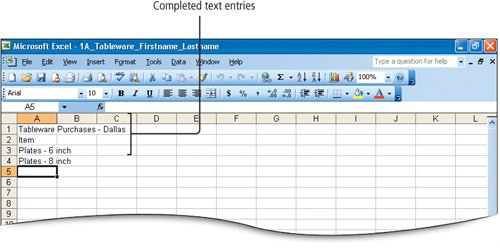
As soon as the entry you are typing differs from the previous value, the AutoComplete suggestion is removed. |
|
|
|
|
6. |
Without correcting the spelling error, in cell A5 type Cofee Mugs and press |
|
7. |
Click cell B2 to make it the active cell. Type Jan and press |
|
8. |
In cell C2, type Feb press Figure 1.32. 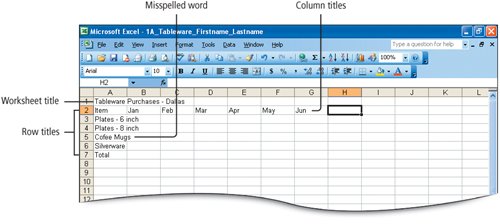
Be sure to confirm the last entry by using  or or  , because entry of a value must be confirmed to make other Excel functions available. , because entry of a value must be confirmed to make other Excel functions available. |
|
9. |
On the Standard toolbar, click the Spelling button Figure 1.33. 
|
|
10. |
Under Not in Dictionary, notice the word Cofee. |
|
11. |
Under Suggestions, click Coffee, and then click the Change button. NoteWords not in the dictionary are not necessarily misspelled Many proper nouns or less commonly used words are not in the dictionary used by Excel. If Excel indicates a correct word as Not in Dictionary, you can choose to ignore this word or add it to the dictionary. You may want to add proper names that you expect to use often, such as your own last name, to the dictionary if you are permitted to do so. |
|
12. |
In the Microsoft Excel dialog box, under Do you want to continue checking at the beginning of the sheet? click Yes. |
|
|
|
|
13. |
Correct any other errors that you may have made. When the message displays The spelling check is complete for the entire sheet, click OK. |
|
14. |
Point to cell A6 and double-clickclick the left mouse button twice in rapid succession while keeping the mouse still. Compare your screen with Figure 1.34. Figure 1.34. 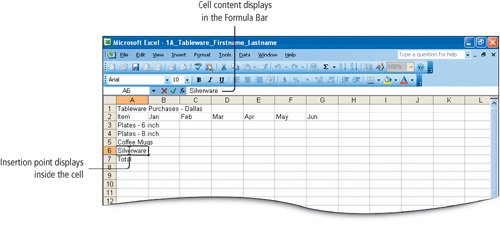
The insertion point displays in the text in cell A6, and the text also displays in the Formula Bar. |
|
15. |
Move the mouse pointer away from the cell so that you have a clear view, and then using the arrow, |
|
16. |
On the Standard toolbar, click the Undo button More Knowledge: Using AutoCorrect AutoCorrect can correct common typing errors. It compares what you type to a list of commonly mistyped words and when it finds a match, it substitutes the correct word. To view the AutoCorrect options, from the Tools menu, click AutoCorrect Options. |
Activity 1.6. Aligning Text and Adjusting the Size of Columns and Rows
You can make columns wider or narrower and make rows taller or shorter. In this activity, you will adjust the size of columns and rows to make space for long item names such as the item titles in column A.
|
1. |
In the column heading area, point to the vertical line between column A and column B to display the double-headed arrow pointer Figure 1.35. 
A ScreenTip displays information about the width of the column. The default width of a column is 64 pixels. A pixel, short for picture element, is a point of light measured in dots per square inch on a screen. Sixty-four pixels equal 8.43 characters, which is the average number of digits that will fit in a cell using the default fonta set of characters with the same design, size, and shape. The default font in Excel is Arial, and the default font sizethe size of characters in a font measured in pointsis 10. There are 72 points in an inch, with 10 points being the most commonly used font size in Excel. Point is usually abbreviated as pt. |
|
2. |
Drag to the right until the number of pixels indicated in the ScreenTip reaches 90 pixels, which is wide enough to display the longest titles in cells A2 through A7. The title in A1 will span more than one column and still does not fit in column A. If you are not satisfied with your result, click the Undo button and begin again. |
|
3. |
Click cell A7, and then on the Formatting toolbar, click the Align Right button |
|
|
|
|
4. |
Select the range B2:G2, and then on the Formatting toolbar, click the Center button |
|
5. |
In the row heading area, position the pointer over the horizontal line between row 1 and row 2 until the double-headed arrow Figure 1.36. 
The height of the row is increased. Row height is measured in points or in pixels. Points are the units in which font size is measured and pixels are units of screen display. The default height of a row is 12.75 points or 17 pixels. |
|
6. |
On the Standard toolbar, click the Save button |
Activity 1.7. Entering Numbers
When typing numbers in an Excel worksheet, you can use either the number keys across the top of your keyboard or the number keys and  key on the numeric keypad. Try to develop some proficiency in touch control of the numeric keypad. On most keyboards, the number 5 key has a raised bar or dot that helps you identify it by touch. On a desktop computer, the Num Lock light indicates that the numeric keypad is active. Use these techniques to increase your speed while entering the purchases for the Dallas restaurant.
key on the numeric keypad. Try to develop some proficiency in touch control of the numeric keypad. On most keyboards, the number 5 key has a raised bar or dot that helps you identify it by touch. On a desktop computer, the Num Lock light indicates that the numeric keypad is active. Use these techniques to increase your speed while entering the purchases for the Dallas restaurant.
|
1. |
Click cell B3, type 77.35 and then press |
|||||||||||||||||||||||||||||||||||
|
2. |
Using the techniques you have practiced, enter the numbers shown in the table. You can type the rows first or the columns first, and use either
|
|||||||||||||||||||||||||||||||||||
|
3. |
Use the technique you have practiced to change the width of column A to 80 pixels, and then click cell A3. Compare your screen with Figure 1.37. Figure 1.37. 
The text in cells A3 and A4 no longer extends into cells B3 or B4 because those cells are now occupied. The text is truncatedcut off. However, the entire text still exists and displays in the Formula Bar. Data displayed in a cell is referred to as the displayed value. Data displayed in the Formula Bar is referred to as the underlying value. The number of digits or characters that appear in a cellthe displayed valuedepends on the width of the column. |
|||||||||||||||||||||||||||||||||||
|
|
||||||||||||||||||||||||||||||||||||
|
4. |
On the Standard toolbar, click the Undo button Figure 1.38. 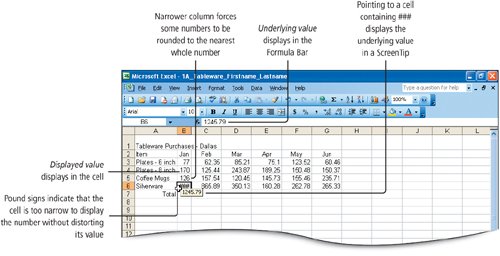
If the column is too narrow to display all of the decimal places in a number, the display of the number will be rounded to fit the available space. Rounding is a procedure in which you determine which digit at the right of the number will be the last digit displayed and then increase it by one if the next digit to its right is 5, 6, 7, 8, or 9. If a cell width is too narrow to display the entire number even after it is rounded to a whole number, Excel displays a series of pound signs instead; displaying only a portion of a whole number would be misleading. The underlying values remain unchanged and are displayed in the Formula Bar for the selected cell. The underlying value also displays in the ScreenTip if you move the mouse pointer over the cell containing ###. NoteMonitor Settings Affect Pixels Depending on the settings for your monitor, changing the pixels for column B to 30 may result in all of the values displaying as ####. Examine Figure 1.38 and continue to step 5. |
|||||||||||||||||||||||||||||||||||
|
5. |
On the Standard toolbar, click the Undo button |
|||||||||||||||||||||||||||||||||||
|
6. |
Select the range A1:G1, and then on the Formatting toolbar, click the Merge and Center button |
Activity 1.8. Inserting Rows
In this activity, you will insert a new row of linen purchases.
|
1. |
Point to the row 3 heading and right-clickpress the right mouse buttonto simultaneously select the row and display the shortcut menu. Compare your screen with Figure 1.39. Figure 1.39. 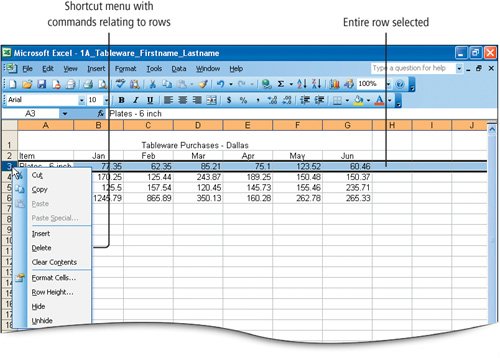
A shortcut menu offers the most commonly used commands relevant to the selected area. |
||||||||||||||
|
2. |
From the displayed shortcut menu, click Insert. |
||||||||||||||
|
|
|||||||||||||||
|
3. |
Point to the Insert Options button Figure 1.40. 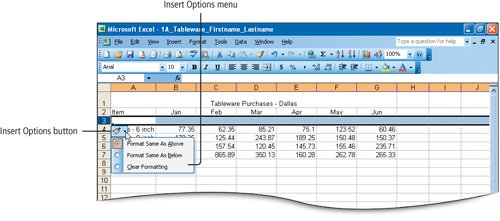
From this menu, you can format the new row like the row above or the row below, or you can leave it unformatted. The default is Format Same As Above. |
||||||||||||||
|
4. |
Click Format Same As Below. |
||||||||||||||
|
5. |
Click cell A3, type Linen and then press |
||||||||||||||
|
6. |
Enter the values for Linen for each month as shown below. Use
|
||||||||||||||
|
7. |
On the Standard toolbar, click the Save button |
Objective 4 Construct a Formula and Use the Sum Function |
Windows XP
- Chapter One. Getting Started with Windows XP
- Project 1A. Windows XP
- Objective 1. Get Started with Windows XP
- Objective 2. Resize, Move, and Scroll Windows
- Objective 3. Maximize, Restore, Minimize, and Close a Window
- Objective 4. Create a New Folder
- Objective 5. Copy, Move, Rename, and Delete Files
- Objective 6. Find Files and Folders
- Objective 7. Compress Files
- Summary
- Key Terms
- Concepts Assessments
Outlook 2003
- Chapter One. Getting Started with Outlook 2003
- Getting Started with Microsoft Office Outlook 2003
- Project 1A. Exploring Outlook 2003
- Objective 1. Start and Navigate Outlook
- Objective 2. Read and Respond to E-mail
- Objective 3. Store Contact and Task Information
- Objective 4. Work with the Calendar
- Objective 5. Delete Outlook Information and Close Outlook
- Summary
- Key Terms
- Concepts Assessments
- Skill Assessments
- Performance Assessments
- Mastery Assessments
- Problem Solving
- GO! with Help
Internet Explorer
- Chapter One. Getting Started with Internet Explorer
- Getting Started with Internet Explorer 6.0
- Project 1A. College and Career Information
- Objective 1. Start Internet Explorer and Identify Screen Elements
- Objective 2. Navigate the Internet
- Objective 3. Create and Manage Favorites
- Objective 4. Search the Internet
- Objective 5. Save and Print Web Pages
- Summary
- Key Terms
- Concepts Assessments
- Skill Assessments
- Performance Assessments
- Mastery Assessments
- Problem Solving
Computer Concepts
- Chapter One. Basic Computer Concepts
- Objective 1. Define Computer and Identify the Four Basic Computing Functions
- Objective 2. Identify the Different Types of Computers
- Objective 3. Describe Hardware Devices and Their Uses
- Objective 4. Identify Types of Software and Their Uses
- Objective 5. Describe Networks and Define Network Terms
- Objective 6. Identify Safe Computing Practices
- Summary
- In this Chapter You Learned How to
- Key Terms
- Concepts Assessments
Word 2003
Chapter One. Creating Documents with Microsoft Word 2003
- Chapter One. Creating Documents with Microsoft Word 2003
- Getting Started with Microsoft Office Word 2003
- Project 1A. Thank You Letter
- Objective 1. Create and Save a New Document
- Objective 2. Edit Text
- Objective 3. Select, Delete, and Format Text
- Objective 4. Create Footers and Print Documents
- Project 1B. Party Themes
- Objective 5. Navigate the Word Window
- Objective 6. Add a Graphic to a Document
- Objective 7. Use the Spelling and Grammar Checker
- Objective 8. Preview and Print Documents, Close a Document, and Close Word
- Objective 9. Use the Microsoft Help System
- Summary
- Key Terms
- Concepts Assessments
- Skill Assessments
- Performance Assessments
- Mastery Assessments
- Problem Solving
- You and GO!
- Business Running Case
- GO! with Help
Chapter Two. Formatting and Organizing Text
- Formatting and Organizing Text
- Project 2A. Alaska Trip
- Objective 1. Change Document and Paragraph Layout
- Objective 2. Change and Reorganize Text
- Objective 3. Create and Modify Lists
- Project 2B. Research Paper
- Objective 4. Insert and Format Headers and Footers
- Objective 5. Insert Frequently Used Text
- Objective 6. Insert and Format References
- Summary
- Key Terms
- Concepts Assessments
- Skill Assessments
- Performance Assessments
- Mastery Assessments
- Problem Solving
- You and GO!
- Business Running Case
- GO! with Help
Chapter Three. Using Graphics and Tables
- Using Graphics and Tables
- Project 3A. Job Opportunities
- Objective 1. Insert and Modify Clip Art and Pictures
- Objective 2. Use the Drawing Toolbar
- Project 3B. Park Changes
- Objective 3. Set Tab Stops
- Objective 4. Create a Table
- Objective 5. Format a Table
- Objective 6. Create a Table from Existing Text
- Summary
- Key Terms
- Concepts Assessments
- Skill Assessments
- Performance Assessments
- Mastery Assessments
- Problem Solving
- You and GO!
- Business Running Case
- GO! with Help
Chapter Four. Using Special Document Formats, Columns, and Mail Merge
- Using Special Document Formats, Columns, and Mail Merge
- Project 4A. Garden Newsletter
- Objective 1. Create a Decorative Title
- Objective 2. Create Multicolumn Documents
- Objective 3. Add Special Paragraph Formatting
- Objective 4. Use Special Character Formats
- Project 4B. Water Matters
- Objective 5. Insert Hyperlinks
- Objective 6. Preview and Save a Document as a Web Page
- Project 4C. Recreation Ideas
- Objective 7. Locate Supporting Information
- Objective 8. Find Objects with the Select Browse Object Button
- Project 4D. Mailing Labels
- Objective 9. Create Labels Using the Mail Merge Wizard
- Summary
- Key Terms
- Concepts Assessments
- Skill Assessments
- Performance Assessments
- Mastery Assessments
- Problem Solving
- You and GO!
- Business Running Case
- GO! with Help
Excel 2003
Chapter One. Creating a Worksheet and Charting Data
- Creating a Worksheet and Charting Data
- Project 1A. Tableware
- Objective 1. Start Excel and Navigate a Workbook
- Objective 2. Select Parts of a Worksheet
- Objective 3. Enter and Edit Data in a Worksheet
- Objective 4. Construct a Formula and Use the Sum Function
- Objective 5. Format Data and Cells
- Objective 6. Chart Data
- Objective 7. Annotate a Chart
- Objective 8. Prepare a Worksheet for Printing
- Objective 9. Use the Excel Help System
- Project 1B. Gas Usage
- Objective 10. Open and Save an Existing Workbook
- Objective 11. Navigate and Rename Worksheets
- Objective 12. Enter Dates and Clear Formats
- Objective 13. Use a Summary Sheet
- Objective 14. Format Worksheets in a Workbook
- Summary
- Key Terms
- Concepts Assessments
- Skill Assessments
- Performance Assessments
- Mastery Assessments
- Problem Solving
- You and GO!
- Business Running Case
- GO! with Help
Chapter Two. Designing Effective Worksheets
- Designing Effective Worksheets
- Project 2A. Staff Schedule
- Objective 1. Use AutoFill to Fill a Pattern of Column and Row Titles
- Objective 2. Copy Text Using the Fill Handle
- Objective 3. Use AutoFormat
- Objective 4. View, Scroll, and Print Large Worksheets
- Project 2B. Inventory Value
- Objective 5. Design a Worksheet
- Objective 6. Copy Formulas
- Objective 7. Format Percents, Move Formulas, and Wrap Text
- Objective 8. Make Comparisons Using a Pie Chart
- Objective 9. Print a Chart on a Separate Worksheet
- Project 2C. Population Growth
- Objective 10. Design a Worksheet for What-If Analysis
- Objective 11. Perform What-If Analysis
- Objective 12. Compare Data with a Line Chart
- Summary
- Key Terms
- Concepts Assessments
- Skill Assessments
- Performance Assessments
- Mastery Assessments
- Problem Solving
- You and GO!
- Business Running Case
- GO! with Help
Chapter Three. Using Functions and Data Tables
- Using Functions and Data Tables
- Project 3A. Geography Lecture
- Objective 1. Use SUM, AVERAGE, MIN, and MAX Functions
- Objective 2. Use a Chart to Make Comparisons
- Project 3B. Lab Supervisors
- Objective 3. Use COUNTIF and IF Functions, and Apply Conditional Formatting
- Objective 4. Use a Date Function
- Project 3C. Loan Payment
- Objective 5. Use Financial Functions
- Objective 6. Use Goal Seek
- Objective 7. Create a Data Table
- Summary
- Key Terms
- Concepts Assessments
- Skill Assessments
- Performance Assessments
- Mastery Assessments
- Problem Solving
- You and GO!
- Business Running Case
- GO! with Help
Access 2003
Chapter One. Getting Started with Access Databases and Tables
- Getting Started with Access Databases and Tables
- Project 1A. Academic Departments
- Objective 1. Rename a Database
- Objective 2. Start Access, Open an Existing Database, and View Database Objects
- Project 1B. Fundraising
- Objective 3. Create a New Database
- Objective 4. Create a New Table
- Objective 5. Add Records to a Table
- Objective 6. Modify the Table Design
- Objective 7. Create Table Relationships
- Objective 8. Find and Edit Records in a Table
- Objective 9. Print a Table
- Objective 10. Close and Save a Database
- Objective 11. Use the Access Help System
- Summary
- Key Terms
- Concepts Assessments
- Skill Assessments
- Performance Assessments
- Mastery Assessments
- Problem Solving Assessments
- Problem Solving
- You and GO!
- Business Running Case
- GO! with Help
Chapter Two. Sort, Filter, and Query a Database
- Sort, Filter, and Query a Database
- Project 2A. Club Fundraiser
- Objective 1. Sort Records
- Objective 2. Filter Records
- Objective 3. Create a Select Query
- Objective 4. Open and Edit an Existing Query
- Objective 5. Sort Data in a Query
- Objective 6. Specify Text Criteria in a Query
- Objective 7. Print a Query
- Objective 8. Specify Numeric Criteria in a Query
- Objective 9. Use Compound Criteria
- Objective 10. Create a Query Based on More Than One Table
- Objective 11. Use Wildcards in a Query
- Objective 12. Use Calculated Fields in a Query
- Objective 13. Group Data and Calculate Statistics in a Query
- Summary
- Key Terms
- Concepts Assessments
- Skill Assessments
- Performance Assessments
- Mastery Assessments
- Problem Solving
- You and GO!
- Business Running Case
- GO! with Access Help
Chapter Three. Forms and Reports
- Forms and Reports
- Project 3A. Fundraiser
- Objective 1. Create an AutoForm
- Objective 2. Use a Form to Add and Delete Records
- Objective 3. Create a Form Using the Form Wizard
- Objective 4. Modify a Form
- Objective 5. Create an AutoReport
- Objective 6. Create a Report Using the Report Wizard
- Objective 7. Modify the Design of a Report
- Objective 8. Print a Report and Keep Data Together
- Summary
- Key Terms
- Concepts Assessments
- Skill Assessments
- Performance Assessments
- Mastery Assessments
- Problem Solving
- You and GO!
- Business Running Case
- GO! with Help
Powerpoint 2003
Chapter One. Getting Started with PowerPoint 2003
- Getting Started with PowerPoint 2003
- Project 1A. Expansion
- Objective 1. Start and Exit PowerPoint
- Objective 2. Edit a Presentation Using the Outline/Slides Pane
- Objective 3. Format and Edit a Presentation Using the Slide Pane
- Objective 4. View and Edit a Presentation in Slide Sorter View
- Objective 5. View a Slide Show
- Objective 6. Create Headers and Footers
- Objective 7. Print a Presentation
- Objective 8. Use PowerPoint Help
- Summary
- Key Terms
- Concepts Assessments
- Skill Assessments
- Performance Assessments
- Mastery Assessments
- Problem Solving
- You and GO!
- Business Running Case
- GO! with Help
Chapter Two. Creating a Presentation
- Creating a Presentation
- Project 2A. Teenagers
- Objective 1. Create a Presentation
- Objective 2. Modify Slides
- Project 2B. History
- Objective 3. Create a Presentation Using a Design Template
- Objective 4. Import Text from Word
- Objective 5. Move and Copy Text
- Summary
- Key Terms
- Concepts Assessments
- Skill Assessments
- Performance Assessments
- Mastery Assessments
- Problem Solving
- You and GO!
- Business Running Case
- GO! with Help
Chapter Three. Formatting a Presentation
- Project 3A. Emergency
- Objective 1. Format Slide Text
- Objective 2. Modify Placeholders
- Objective 3. Modify Slide Master Elements
- Objective 4. Insert Clip Art
- Project 3B. Volunteers
- Objective 5. Apply Bullets and Numbering
- Objective 6. Customize a Color Scheme
- Objective 7. Modify the Slide Background
- Objective 8. Apply an Animation Scheme
- Summary
- Key Terms
- Concepts Assessments
- Skill Assessments
- Performance Assessments
- Mastery Assessments
- Problem Solving
- You and GO!
- Business Running Case
- GO! with Help
Integrated Projects
Chapter One. Using Access Data with Other Office Applications
- Chapter One. Using Access Data with Other Office Applications
- Introduction
- Project 1A. Meeting Slides
- Objective 1. Export Access Data to Excel
- Objective 2. Create a Formula in Excel
- Objective 3. Create a Chart in Excel
- Objective 4. Copy Access Data into a Word Document
- Objective 5. Copy Excel Data into a Word Document
- Objective 6. Insert an Excel Chart into a PowerPoint Presentation
Chapter Two. Using Tables in Word and Excel
- Chapter Two. Using Tables in Word and Excel
- Introduction
- Project 2A. Meeting Notes
- Objective 1. Plan a Table in Word
- Objective 2. Enter Data and Format a Table in Word
- Objective 3. Create a Table in Word from Excel Data
- Objective 4. Create Excel Worksheet Data from a Word Table
Chapter Three. Using Excel as a Data Source in a Mail Merge
- Chapter Three. Using Excel as a Data Source in a Mail Merge
- Introduction
- Project 3A. Mailing Labels
- Objective 1. Prepare a Mail Merge Document as Mailing Labels
- Objective 2. Choose an Excel Worksheet as a Data Source
- Objective 3. Produce and Save Merged Mailing Labels
- Objective 4. Open a Saved Main Document for Mail Merge
Chapter Four. Linking Data in Office Documents
- Chapter Four. Linking Data in Office Documents
- Introduction
- Project 4A. Weekly Sales
- Objective 1. Insert and Link in Word an Excel Object
- Objective 2. Format an Object in Word
- Objective 3. Open a Word Document That Includes a Linked Object, and Update Links
Chapter Five. Creating Presentation Content from Office Documents
EAN: 2147483647
Pages: 448
 , and then compare your screen with Figure 1.33.
, and then compare your screen with Figure 1.33. , or
, or  keys as necessary, edit the text and change it to Flatware Confirm the change by pressing
keys as necessary, edit the text and change it to Flatware Confirm the change by pressing  . Alternatively, you can press
. Alternatively, you can press  on the keyboard to reverse (undo) the last action.
on the keyboard to reverse (undo) the last action. , press and hold down the left mouse button, and then compare your screen with Figure 1.35.
, press and hold down the left mouse button, and then compare your screen with Figure 1.35. .
. .
. displays. Drag downward until the height of row 1 is 32 pixels, and then compare your screen with Figure 1.36.
displays. Drag downward until the height of row 1 is 32 pixels, and then compare your screen with Figure 1.36. to save the changes you have made to your workbook; make it a habit to save your work frequently.
to save the changes you have made to your workbook; make it a habit to save your work frequently. .
. to display its ScreenTip and its arrow, click the arrow to display a menu, and then compare your screen with Figure 1.40.
to display its ScreenTip and its arrow, click the arrow to display a menu, and then compare your screen with Figure 1.40.